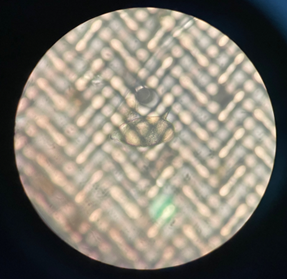
Photo: A view at x100 of an egg of Schistosoma mansoni, with its lateral spine pointing upwards. This egg was found in the urine of a child with concurrent urogenital schistosomiasis. Ectopic eggs such as these are surprisingly common. We now suspect this species is a catalyst that changes the mating behaviour(s) of Schistosoma haematobium and Schistosoma mattheei worms.
On 20th September all members of the HUGS team attended an online meeting and presented their findings so far. The UK-Malawi team then discussed plans for the second half of the project as we take advantage of our new insights into transmission biology of hybrid schistosomes and clinical disease.
A review of our pilot study findings reminded us that across four schools in Mangochi District, urogenital schistosomiasis prevalence was 43% and across four schools in Nsanje District prevalence was 38%. Additionally, 305 children at the four schools in Mangochi were surveyed for intestinal schistosomiasis which was 37%. Based on these results, the communities of Samama and Mthawira villages in Mangochi and Nsanje Districts respectively were selected for the main HUGS human study. It was also found that 305 children surveyed in Mangochi had a 39.3% prevalence of the parasite that causes giardiasis by PCR diagnosis. Later in the year our pilot findings will be written up, encouraging more junior members of the Malawi team to gain first-authorships.
Later large-scale human studies in Samama and Mthawira recruited then examined 1,228 and 1,050 people respectively in the baseline survey in July 2022; these individuals were then followed-up a year later, inspecting 1,126 and 836 people. The baseline study showed urogenital schistosomiasis, by urine filtration, to be 51.2% and 34.2% across the communities in Samama and Mthawira, respectively. Despite treatment with praziquantel in August 2022, prevalence of urogenital schistosomiasis at follow-up was 43.1% and 45.4%. At these two timepoints, urine filters and individually hatched miracidia have been preserved for molecular testing in Liverpool using our newly developed HRM method to detect hybrids. Of particular note, during the follow-up survey we conducted our clinical inspections for female genital schistosomiasis and male genital schistosomiasis, alongside general health checks, screening for Trichomonas vaginalis and for Human Papilloma Virus.
The HUGS search for hybrid schistosomes in cattle has been successful; cattle appear to be competent hosts for both Schistosoma mattheei and Schistosoma haematobium and their hybrids. The prevalence of schisosomiasis infection in cattle is high, with about 70% in Mangochi District, 63% in Chikwawa District and 12% in Nsanje District. Cattle were monitored through postmortem examination at local abattoirs, in addition to faecal examination and hatching of parasites. Two herds in Mangochi were tracked with GPS dataloggers to ascertain their water contact habits. These herds were also treated with praziquantel and monitored for reinfection. This study was particular effective demonstrating that, although treatment was 100% effective at 1-month inspection, all animals were reinfected at 3-month inspection. Cattle would typically spend up to 45 minutes in lake water each day and, in so doing, quickly reacquire schistosome infection(s).
Snail studies have been conducted routinely for almost two calendar years. This has been conducted at seven sites in Mangochi District, two sites in Chikwawa District and three sites in Nsanje District. These seven sites were narrowed down from 36 total sites surveyed in the pilot study. Six of the 12 HUGS sites have had Bulinus snails that have been infected with schistosome parasites, four sites in Mangochi and two in Nsanje. Across all the HUGS sites and across all time points 22.1% of collected snails have been positive for schistosome DNA. Individual parasites shed from the snails and collected on FTA cards have been processed to speciate them, this has revealed snails shedding pure S. mattheei, pure S. haematobium and hybrids of S. mattheei and S. haematobium. Snails have been barcoded to identify their species, this has confirmed earlier reports of Bulinus angolensis in Lake Malawi.
From our results it is evident that increased praziquantel treatment frequency is needed in our study locations as well as social science studies to better understand community perceptions MGS/FGS. HUGS is starting to fill in key knowledge gaps concerning the major role that cattle and certain snails play in the transmission cycle of urogenital schistosomiasis and hybrid schistosomes therein.